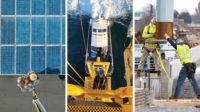Cleaner Energy
Hydrogen Gains Global Momentum to Fuel Cleaner Energy Drive

As a low-carbon-emitting energy source, hydrogen is gaining new global momentum, with nations eyeing net-zero greenhouse gas-emission targets as they transition from fossil fuels.
Hydrogen can be extracted from natural gas and other fossil fuels through carbon-capture technology, commonly known as “blue” hydrogen, or from renewable energy sources or from water by electrolysis, termed “green” hydrogen.
The Hydrogen Council estimates hydrogen as an energy source could become a $2.5-trillion industry by 2050. “Hydrogen as a complementary byproduct of natural gas has a powerful role to play in the world’s future,” it says.
A blend of hydrogen and natural gas will fuel the 485-MW Long Ridge Energy Terminal combined cycle power plant beginning in November 2021—for the first time in the U.S.—also putting the unit on a path to burn 100% hydrogen in the next decade, plant owner New Fortress Energy said on Oct. 13.
The $588-million project is a collaboration with GE Power that will use the firm's H-class gas turbine, which can burn 15% to 20% hydrogen.
The project, under construction in Hannibal, Ohio, on the Ohio River in the Marcellus and Utica shale natural gas formations, will be the U.S. pioneer in blending hydrogen in GE’s H-class gas turbine, according to GE.
The project executed an EPC contract with Kiewit Power Constructors Co. for design and construction in early 2019. Black & Veatch is assisting with engineering the integration of hydrogen into the natural gas.
Clean Fuel Adjustment
GE says it has more than 70 gas turbines globally that support power generation with hydrogen and associated fuels. Its turbines are adjusted for the hydrogen, which burns hotter than natural gas and is more reactive, the company says.
Certain GE gas turbines that burn hydrogen and other alternative fuels can be upgraded to for greater levels of the alternatives. Some can burn 100% hydrogen, “a compelling reason why gas turbines can and will play an important role in the future of electricity,” the company says.
One challenges of using hydrogen as a fuel is efficiently extracting it from hydrocarbons, according to the U.S. Energy. Dept. Combining high-temperature steam with natural gas to extract hydrogen accounts for most of the hydrogen produced in the U.S., the agency said. Hydrogen fuel also can be produced from water through electrolysis.
GE has a source of industrial by-product hydrogen and will produce green hydrogen with the electrolysis, with salt formations used for long-term hydrogen storage, it says.
Singular Focus
New Fortress Energy is an energy infrastructure company founded to help accelerate the transition to clean energy, the firm said. It funds, builds and operates natural gas infrastructure and has a division that will deploy new hydrogen-production technology.
“Our singular focus has been to identify and support clean technologies that can eventually produce hydrogen at commercially attractive prices," says New Fortress Energy CEO Wes Edens. "As we continue to make progress in our efforts and advance proof of concept projects, this experience will bring tremendous value."
The energy terminal is a massive 1,600-acre project that includes rail terminals and a natural gas pipeline. It received $20 million in federal funding for a railyard and pipelines to increase project capacity and connect it to existing rail lines—giving the region’s natural gas better access to global markets, said U.S. Sen. Sherrod Brown,(D-Ohio), when the funding was announced in December 2018.
GCM Grosvenor, a private global alternative asset-management firm, owns 49.9% of the Long Ridge Terminal through its labor impact fund, which invests in infrastructure projects that encourage the use of union labor.
Hydrogen Strategy in Canada
Alberta sees hydrogen’s potential to boost its critical but sagging oil-and-gas industry—announcing last month a strategy to establish the province as a key exporter of hydrogen and hydrogen-derived products across North America and the world by 2040, said Dale Nally, associate minister of natural gas. The province will align its hydrogen development with British Columbia and Saskatchewan to accelerate deployment in western Canada.
Construction of Canada’s largest hydrogen-blending project, at Fort Saskatchewan, Alberta, is set to start early next year. It will inject up to 5% hydrogen by volume into a section of the city’s residential natural gas-distribution network to about 5,000 customers.
Led by ATCO Group unit Canadian Utilities, the project effectively “decarbonizes heat,” said CEO Nancy Southern. It will use hydrogen from domestically produced natural gas eventually to leverage Alberta’s existing carbon capture and sequestration infrastructure to store emissions, according to Canadian Utilities.
Europe's Roadmap
The European Union's roadmap to increase use of low-emission hydrogen as an energy source includes installation of at least six gigawatts of renewable hydrogen electrolyzers and production of just over 1 million tons of the substance by 2024. Further plans call for backbone transmission infrastructure as well as large wind and solar plants dedicated to gigawatt-scale renewable hydrogen production by the end of the decade.
Among current signs of support are recent agreements by German utility giant RWE and a German-Dutch joint venture to explore adding capacities for hydrogen to a planned new liquified natural gas (LNG) terminal along the mouth of the Elbe River south of Hamburg, potentially making it a dual-use import facility and distribution point for hydrogen to be used as a low-emission fuel for industry and transport.
The Elbe terminal is going through final site planning by the joint venture—German LNG Terminal, made up of Gasunie LNG Holding and Vopak LNG Holding from the Netherlands and a subsidiary of Marquard & Bahls of Hamburg.
An engineering partnership made up of COBRA Instalaciones, SENER Ingeniería and TGE Gas Engineering, is now shortlisted to gain the engineering, procurement and construction contract for the project. The deal is expected to close by the end of December.
Meanwhile, France’s Air Liquide has led a consortium running a prototype facility in Hobro, Denmark that produces hydrogen using excess grid electricity from wind and solar power facilities.
The Hobro plant has produced 120 tons of hydrogen through its 1.2-MW proton-exchange membrane electrolyzer since opening as a pilot project in 2018.
The electrolyzer splits water into hydrogen and oxygen, essentially converting excess energy produced by renewables into a storable resource. The fuel from Hobro went to power a nearby industrial facility as well as a fleet of taxis in Copenhagen. Air Liquide will continue to run the plant to supply hydrogen to customers.





